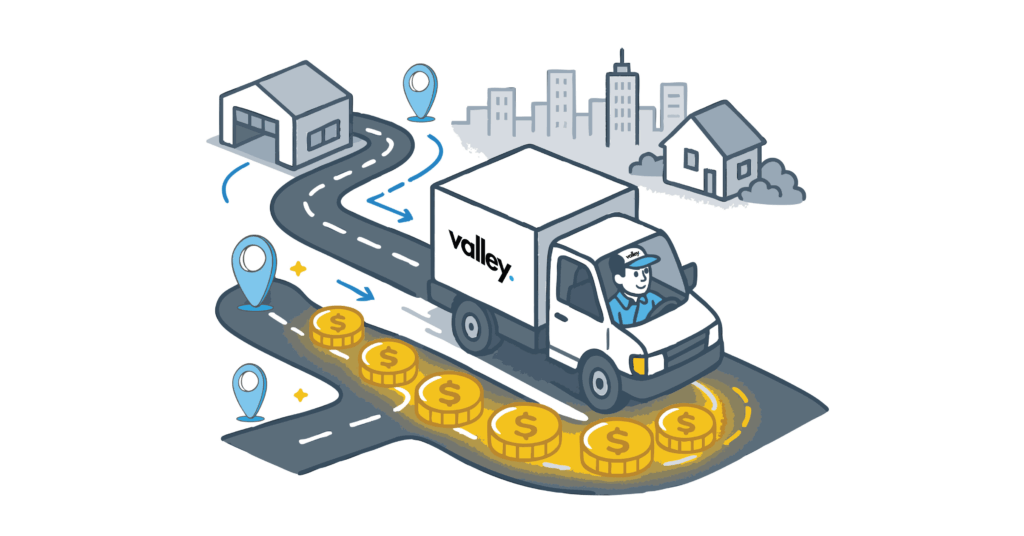From Point A to Profit: How Route Optimization Can Help You Make More Money

Every mile matters in trucking. It’s not just the fuel that gets used up. Extra miles also mean more hours for the driver, more wear and tear on the equipment, and missed chances to get new business.
Finding the fastest way to get from Point A to Point B is just the beginning of route optimization. When done right, it is one of the best ways to protect margins and make room for growth.
The Unseen Price of “One More Mile”
The cost of miles that are wasted adds up fast. For instance:
- If a driver drives just 15 extra miles a day in a fleet of 20 trucks, that’s more than 100,000 extra miles in a year.
- At today’s average cost per mile, that means tens of thousands of dollars are quietly disappearing from profits.
- There are also hidden costs besides gas, like maintenance, overtime pay, late delivery fees, and more stress on drivers.
For fleets that are already working with tight margins, wasted miles can make the difference between a year with profits and one with losses.
Proof in the Real World
One national freight company started using an AI-powered routing system that took into account traffic, delivery windows, and weather conditions in real time. The results were very important:
- There was a 22% rise in on-time deliveries over the course of a year.
- Without adding trucks or hiring drivers, the company saved more than $500,000.
- Planning became more efficient, which gave dispatchers more time to work on more important tasks.
This isn’t the only time this has worked:
- Studies in the industry show that smarter routing tools can cut overall operating costs by 10% to 20%.
- Delivery times get better, which makes customers happier.
- Fleets that stop using manual scheduling say they save up to 70% of the time they spend planning.
How to Get Route Savings
You don’t always have to spend a lot of money on new technology to make routing better. Fleets of all sizes can start small and grow from there.
To start optimizing routes, you need to do the following:
- Look at your most expensive lanes: Check routes that use a lot of fuel every three months to see where you can make changes.
- Try out new tools: Test an optimization system on one busy lane and keep track of costs per mile, on-time performance, and customer feedback.
- Listen to what drivers have to say: Drivers often know about problems, delays, or shortcuts that software doesn’t. Give them a reason to share their thoughts.
- Give dispatchers training and power: A lot of fleets don’t use all of the features of GPS and load planning platforms. Training gets the best results.
- Be able to change: Things like weather, traffic, and last-minute changes happen. Fleets that change quickly save money and lower their risks.
- Slowly add more routes: Once you see savings in one area, add more routes until the whole network is covered.
The Ripple Effect of Better Routes
Optimization has many benefits besides saving fuel.
- Happier drivers: Fewer wasted miles mean less stress and more predictable schedules.
- Satisfied customers: On-time deliveries build trust and strengthen long-term relationships.
- Healthier trucks: Vehicles that travel fewer unnecessary miles experience less wear and fewer breakdowns.
- Lower risk: Smarter routes reduce time spent in traffic, lowering the chance of accidents or costly claims.
Better routing doesn’t just help the bottom line. It makes the whole operation stronger.
FAQs on Route Optimization
Is route optimization just for big fleets?
No. Smaller fleets can start by looking at their most expensive lanes and then add routing tools as they see savings.
What kinds of savings can fleets expect?
Studies show that costs can go down by 10% to 20%, depending on the size of the fleet and how well it is currently running.
What role do drivers play in optimization?
Driver input is very important. They can point out traffic problems that happen a lot or shortcuts that software might miss.
Do routing systems take the place of dispatchers?
No. They help dispatchers by automating tasks that are done over and over again and giving them better information to make decisions.
How much money does routing technology make back?
Most fleets see a return on their investment within the first year because they save money on fuel, have fewer delays, and plan better.
The Road Ahead
The lesson is clear, optimizing routes is not a luxury. It’s one of the quickest ways to protect your margins, make things more reliable, and get ready for growth in the future.
Small changes add up quickly, whether you run a small regional fleet or a nationwide network. The road may not always be what you expect, but your plans and routes can be.
Fleets can make every mile an opportunity for profit, safety, and better operations by using better planning, driver input, and the right tools.
